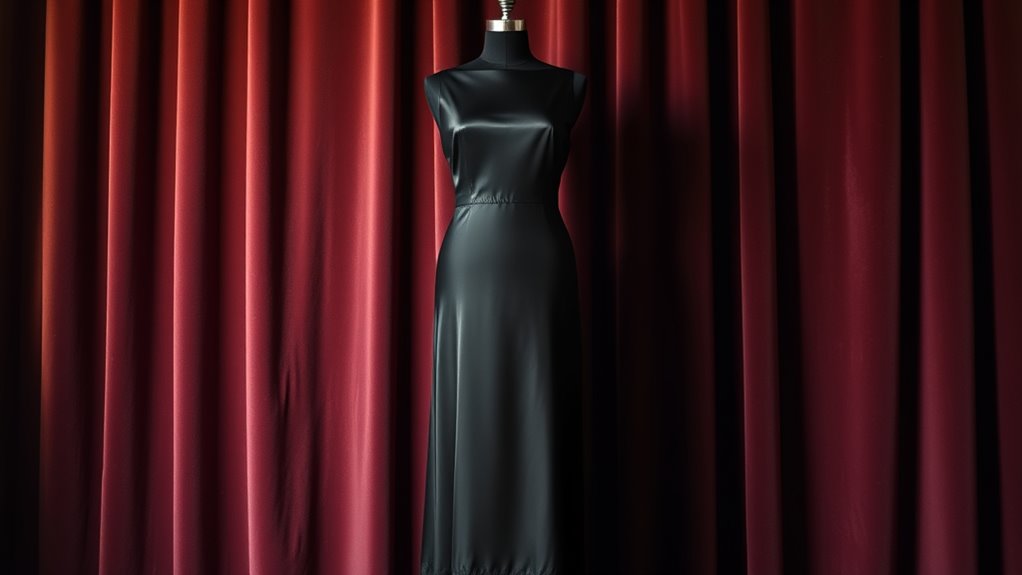The little black dress has a fascinating history that goes beyond fashion trends. It started as mourning wear but transformed into a symbol of empowerment, independence, and sophistication thanks to designers like Coco Chanel. Over the decades, it reflected societal shifts, from rebellion in the 60s to allure on the silver screen. If you look closer, you’ll see how this iconic garment captures cultural change and personal expression. Keep exploring to uncover more about its rich, untold story.
Key Takeaways
- The Little Black Dress evolved from mourning attire to a symbol of independence, confidence, and sophistication in the early 20th century.
- Coco Chanel revolutionized black fashion with her simple, versatile design, making the LBD a wardrobe staple.
- Hollywood icons like Audrey Hepburn popularized the LBD, elevating it as a symbol of glamour and allure.
- The dress’s design has continuously adapted, reflecting societal shifts towards individuality, inclusivity, and rebellion.
- The LBD embodies cultural symbolism, serving as a personal expression tool and reflecting changing societal values over decades.

Have you ever wondered why the little black dress has become a timeless wardrobe essential? Its status isn’t just about style; it’s deeply rooted in the fashion evolution and cultural symbolism that have shaped its significance over the decades. The story of the LBD begins in the early 20th century, when fashion was undergoing rapid change. Before then, black was primarily reserved for mourning, symbolizing grief and solemnity. But as designers started experimenting with new silhouettes and fabrics, black shifted from a symbol of sorrow to a statement of elegance and modernity. Coco Chanel played a pivotal role in this transformation, introducing a simple, versatile black dress that could be worn for multiple occasions. Her design broke away from the ornate, restrictive dresses of the Victorian era, embodying a new era of freedom and minimalism in fashion.
As the years progressed, the little black dress evolved alongside societal changes, reflecting shifting cultural values. During the 1920s, it became a symbol of independence for women, embodying a break from traditional gender roles. It was no longer just about mourning but about making a statement—about confidence, sophistication, and rebellion against convention. Hollywood’s golden age further cemented its status, with actresses like Audrey Hepburn and Marilyn Monroe donning iconic LBDs that became symbols of glamour and allure. These images helped elevate the dress from mere clothing to a cultural icon representing empowerment and style.
Throughout history, the little black dress has adapted to fit the cultural symbolism of the times. In the 1960s and 70s, it took on a more rebellious tone, with designers experimenting with cuts and accessories to challenge traditional notions of femininity. Its versatility makes it suitable for both formal and casual settings, which has contributed to its enduring popularity. Today, it continues to evolve, embracing diverse styles that reflect contemporary values around inclusivity and individuality. Its versatility makes it more than just a fashion statement; it’s a canvas for personal expression and cultural identity. The enduring appeal of the LBD lies in its ability to transcend trends, symbolizing both simplicity and sophistication, and acting as a mirror to societal shifts. Ultimately, the little black dress is not just about fashion evolution or cultural symbolism—it’s about how clothing can encapsulate the spirit of an era and empower the individual wearing it.
Frequently Asked Questions
How Did the Little Black Dress Influence Women’s Social Freedoms?
The little black dress revolutionized women’s social freedoms by challenging traditional fashion norms and promoting gender equality. As you embraced its simplicity and elegance, you supported fashion activism that empowered women to express themselves confidently. This iconic piece symbolized independence and modernity, helping break societal barriers. By wearing the little black dress, you contributed to shifting perceptions, making way for greater gender equality and encouraging women to assert their individuality through style.
Who Were the Key Designers Behind the Lbd’s Evolution?
Ever wonder who shaped the iconic LBD’s evolution? You’ll find that designers like Coco Chanel, who introduced sleek simplicity, and Hubert de Givenchy, who crafted timeless elegance, played key roles. Their design innovations transformed the LBD into a versatile wardrobe staple. Fashion icons like Audrey Hepburn further popularized it, cementing its status. These visionaries’ creative pushes continue to influence how you see and wear this timeless piece today.
What Materials Were Historically Used in Early Little Black Dresses?
You’d find that early little black dresses used simple, affordable fabrics like wool, silk, and cotton. Textile innovations improved fabric quality, making dresses more comfortable and stylish. Dyeing techniques allowed for deeper, richer black hues, which became a hallmark of the LBD’s elegance. These materials and methods made the dress accessible and versatile, helping it become a timeless staple in women’s wardrobes worldwide.
How Has the Lbd’s Symbolism Changed Over Different Decades?
You see, the LBD’s symbolism has evolved with the fashion industry and celebrity influence. In the 1920s, it represented liberation and modernity, while during wartime, it became a symbol of resilience. In the 1960s and beyond, celebrities like Audrey Hepburn and Marilyn Monroe cemented its status as timeless elegance. Today, it’s often seen as versatile, empowering, and a blank canvas for personal style, reflecting changing cultural values and social norms.
Are There Cultural Equivalents of the Little Black Dress Worldwide?
You’ll find cultural dress around the world that serves as a fashion symbolism, much like the LBD. For example, the Japanese kimono, Indian saree, or African dashiki all carry deep cultural significance. These garments act as fashion symbols representing tradition, identity, and social status. While their styles differ, they share the role of embodying cultural values and history, making them powerful equivalents to the iconic little black dress globally.
Conclusion
So, next time you slip into your little black dress, remember it’s more than just a wardrobe staple. It’s a quiet testament to elegance and innovation, subtly whispering stories of change and timeless charm. Its understated grace invites you to feel confident and sophisticated, all while carrying a hint of history. Embrace it, and let it remind you that sometimes, the simplest choices can carry the most enduring stories.








